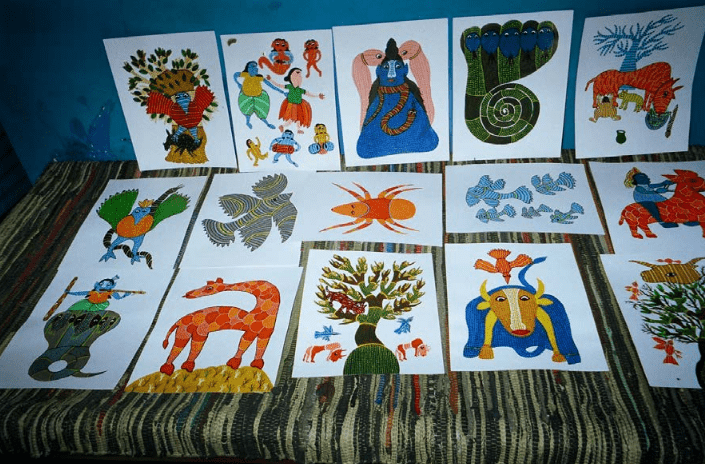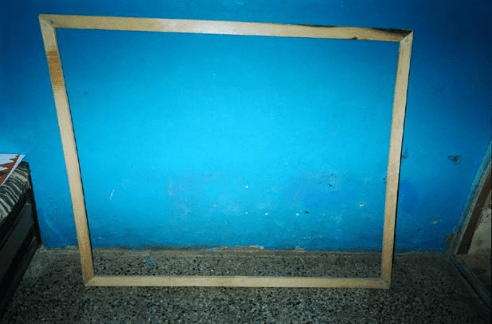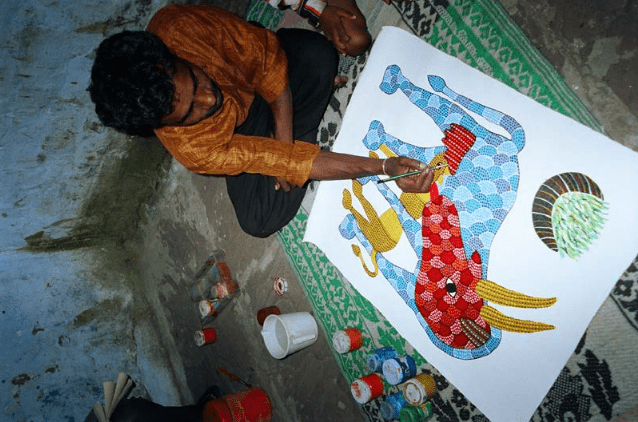Introduction to Gond Painting
History of Wall Painting in India
The oldest wall paintings in India are found in the caves of Bhimbetka [one of the World Heritage Sites [WHSs] declared by United Nations Educational Scientific and Cultural Organization [UNESCO]], around 60 kilometers from Bhopal in Madhya Pradesh.
These paintings are said to be about 20,000 to 500,000 years old. They depict a variety of subjects such as animals, the hunting of wild animals, religious symbols and snapshots from day-to-day life. The colors used are white, red and black derived from various natural sources.
Apart from Bhimbetka, Panchmarhi and Bagh in Madhya Pradesh and the Nilgiris in the south are the other areas in India where ancient cave paintings have been found.
Gond Tribe
Gond is the largest tribe in India with a population of about 7.4 million. Gond tribes inhabit several states, prominently, Madhya Pradesh, Chhattisgarh, Maharashtra and Andhra Pradesh.
They are the original inhabitants of central India and have a glorious history of empires and victories. They also have a very rich culture replete with tribal traditions.
In Madhya Pradesh, the tribe falls under the Central Cultural Zone which covers the districts of Mandla, Dindori, Balaghat, Seoni, Chhindwara, Jabalpur, Katni, Narsimhapur, Sagar, Damoh, Umaria, Sehore and Bhopal.
Common Themes of Tribal Paintings
The tribal households are decorated with paintings as the people invest their spare time in such creative activities and hobbies.
They are also a part of religious festivities and social events like marriages and so forth. Many a time the paintings symbolize supernatural entities and deities in the form of trees and animals.
The common themes for tribal paintings are: Mythological stories depicted in epics like the Ramayana or Mahabharata, nature in the form of forests, agricultural fields, domestic as well as wild animals and some significant events in the life of the painter like marriage, a certain festival or death, etc.
Regions of Tribal Painting in India
Apart from Gond tribal paintings in central India there are some other areas where tribal paintings are found.
These are Southern Gujarat and northern Maharashtra: Warli tribal paintings Himachal Pradesh: Thankas [Tibetan paintings] Madhya Pradesh and Gujarat: Pithora paintings by the Rathwa Bhil tribe Regions of Orissa: Santhal Tribal paintings.
Producer Communities
In Madhya Pradesh, the people of the Gond community are noted for their paintings.
However, even people from the Baiga tribe another central Indian tribe which collects medicinal herbs in the forests for its livelihood] are known for their tribal paintings.
Both the male and female embers of the family engage themselves in this activity.
Raw Materials
Tribal painting is done mainly on the mud walls of the houses in the villages.
However, the tribal’s are now painting on canvas and chart paper as well. For each of these the raw material requirement is different.
Wall Paintings
The following raw material is required for the wall paintings:
Soil: A special soil called pidor is used for preparing the surface of the wall for the painting. This soil is freely available in the area and local people sell it from village to village on bullock carts at very cheap rates.
Natural colors: Various natural materials are used for providing different colors to the drawings. For example, wooden coal for the color black, chui soil for white, red soil or geru forred, the sap of the tinsak plant for dark red, ramraj soil for yellow, sem leaves for dark green and cow dung for light green.
Canvas/Chart Paintings
The following raw material is required for the canvas or chart paper paintings:
Canvas/Chart paper: The canvas is purchased from the local dealers per meter depending on the quality of the cloth. The chart paper is also easily available in the local stationery shops.
Paints: Acrylic paints used for painting fabric are used.
Tools Used
The few tools that are used in tribal paintings are as follows: Wall paintings: For wall paintings the locally made brush [called koochi in the local parlance] is used. This brush is made with the fibers obtained by crushing the bark of some locally available trees.
Canvas/Chart paper paintings: The main tools required for canvas or chart paper paintings include a wooden frame on which the canvas/chart paper is fixed with the help of drawing pins to straighten it.
Apart from this, different brushes [numbers 6 to 4] are used depending on the requirements of the drawing. Fevicol and plastic emulsions are used as primers on the canvas.
Process of Tribal Painting
The process of tribal painting has the following steps:
Deciding the Theme
Deciding the theme is as important in a tribal painting as it is in other paintings. An idea sparked by some event, thought or happening in the life of the artist serves as the theme and the artist starts thinking about its possible representations, various color combinations, etc.
The specialty of tribal paintings is the simplicity of the ideas and their representation of the day-to-day life of rural people.
Preparing the Canvas
In the case of wall paintings the artist first plasters the area of the wall to be painted with a paste of soil, cow dung and straw. After it dries, the area is coated with a white soil called pidor applied which provides a smooth, white background to be used as a canvas.
In the case of canvas paintings the canvas is first cut into the desired size [of about 3 feet by 2 feet] by the artist and is stretched over a wooden frame using drawing pins to straighten it.
After this, a coat of Fevicol is applied on the canvas followed by one to three coats of plastic emulsion to provide a smooth surface. Then it is left to dry. After it has dried it is ready to be used for painting.
For painting a chart, the chart paper of desired size [about 2 feet by 1.5 feet] is purchased from the local dealers.
Both acrylic paint as well as a 0.04 tip drawing pen is used for making these paintings. While the acrylic-painted drawings are multicolored, those made by using the drawing pens are simple black-and-white sketches.
Painting
In tribal painting since designs are not first created on the canvas, the painting starts immediately after the canvas is ready. These can be painted on walls as well as on canvas.
In the case of wall paintings, natural colors like different colored soils and other materials [wooden coal for the black, chui soil for white, red soil or geru for red, the sap of the tinsak plant for dark red, ramraj soil for yellow, sem leaves for dark green and cow dung for light green] are used with locally made brushes of the fibers obtained from the trees.
In the case of canvas paintings, the canvas is fixed on a wooden frame with the help of drawing pins and is colored by using brushes of different widths as per the requirement.
Different colors are used to paint different objects like trees, animals, etc. Some colors have specific associations with emotions, for example: religious thoughts–orange, fear–red, association with nature–green and so on.
Charts are also painted in a similar way. They are easy to draw on because minimum effort is required to prepare them as well as to store and transport them.
The main problem with charts is the lack of a finishing shine which is ample in case of the canvas.
Finishing
Tribal paintings as such do not require any finishing because of their simplicity and the use of local resources. The wall painting, if properly protected from the rain and other sources of physical damage, can survive up to 20 years.
The durability of the canvas and chart paintings is much higher if they are framed properly. Framing is not part of the enterprise and is not done by the artist.
The paintings are ready to be sold immediately after they dry.
Use of the Product
Tribal paintings provide an ethnic, traditional and aesthetic view of the remote tribal village life.
Therefore, these paintings are in demand in the art emporiums and exhibitions to be used as decorative pieces in homes and offices.
Marketing
Tribal paintings on canvas and chart paper are ordered and purchased by various emporiums and handicraft export houses in Bhopal, Delhi and Mumbai.
The artists do not sell their paintings directly to the end customers.
Changes in the Recent Years
The major change that has occurred is that earlier the paintings used to be only on the walls of houses and therefore they were not saleable.
At the most, an art collector could take their photograph to use as an exhibit. Now due to the introduction of canvas and chart paper as well as acrylic colors, these paintings can be sold and transported to the buyer’s address.
The demand for these paintings is on the rise and this is evident from the fact that every year a few more rural artisans join those based in cities like Bhopal, creating the paintings on canvas and chart paper.
As a result of these changes the natural colors of soil, coal and various tree products are no longer used and there is a change in the color shades as the chemical colors cannot always substitute a particular shade of a natural color.








